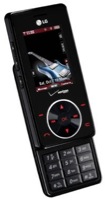

Apple iPhone vs LG Prada KE850
Compared to what's available in the US market now, Apple's new iPhone looks as if it dropped out of the future. How does iPhone compare with new phones on the horizon? And how quickly will existing mobile makers respond to match or improve upon Apple's offerings?
Here's a comparison of the iPhone next to one of the latest new phones to be announced, LG's Prada phone, also known as the KE850.
LG: Forth Largest Mobile Maker



LG is a Korean company, known as Lucky-Goldstar until 1995. Americans may be more familiar with the former Goldstar brand, which was common among the cheap TVs at K Mart. More recently, the LG brand has been associated with the popular Chocolate phone.
The LG Chocolate phone started as a GSM phone in Europe and Asia, and was brought to the US as a CDMA phone for Verizon just last summer. For the US market, the Chocolate phone was changed to mimic the iPod's round user control, just like Microsoft's Zune.
Unlike the Zune's round button or the iPod's original clickwheel trackpad, the LG Chocolate’s circle controller is a touch sensitive panel with no tactile buttons.
It therefore makes sense to find that LG's next new phone ditches buttons almost entirely to present a sleek form factor with a touch screen covering nearly the entire face.
The phone was announced in early December, and the design was leaked as early as the middle of December, although it didn't get much press until the release of the iPhone three weeks later, and wasn’t officially revealed until a week after the iPhone’s launch at Macworld Expo.
LG Prada vs the Sorry State of the Art
Yesterday’s Phone Wars: iPhone vs TyTN, Treo, Pearl, E62, P990, Q compared Apple's new iPhone in price and features against popular phones now on sale. It put existing smartphones into four main buckets:
-
•High-end European phones like the Symbian-based Sony Ericsson P990 provide all the latest hardware features, but are around $700, 3G data service only works in Europe, and GSM reception in the US is limited.
-
•World phone / pocket computers like the Windows Mobile HTC TyTN list closer to $900, work everywhere, but pair clumsy hardware and software, resulting in an expensive toy for gadget lovers who like to struggle.
-
•Mass market Windows Smartphones are $300-400 and offer basic mobile features. A few provide faster 3G data service, but most lack WiFi. They have tiny screens, thumb keyboards, and mini apps.
-
•Practical smartphones from Palm and RIM focus on a large display and PDA functions or instant push messaging to deliver an addictive product to business users. They range from $300-650 new, but older models are available for less.
LG's new Prada fits into the high-end European bucket. It's listed for 600 Euros, or around $775, making it more expensive than even the Sony Ericsson P990.
That's apparently the unlocked price, so with a vendor subsidy, it would be the same price as the iPhone: around $500. That helps to explain why LG plans to sell the new phone in Prada stores, but Prada also actually helped design the phone.
As the previous article noted, there are three barriers that fracture the mobile market; comparing mobiles as a simple feature checkbox review ignores the real world factors that play into how phones will compete. In order to inject some reality, here’s a quick summary of those carrier subsidy, technology, and territory factors.
Cheaper with Two Dozen Months
All smartphones are designed to sell service. With data service plans costing a minimum of $2000 over two years, American carriers have no problem offering a $250 phone contract subsidy. Many also offer rebates to new customers, as an incentive to switch mobile service providers.
Both incentives are enforced by a carrier subsidy lock: in exchange for a deeply discounted phone, the provider locks the phone to only work with their network. Locks can be removed, and unlocked phones can also be bought at full price.
Another incentive to switch providers involves exclusive access to the latest phones. For example, Sprint arranged for an exclusive contract to deliver the first Palm Treo 650, and Verizon Wireless was initially the exclusive carrier of the Motorola Q and LG Chocolate.
Technology and Territory Locks
In addition to subsidy lock, there's another complication plaguing the US mobile industry: non-standard service. While much of the rest of the world uses GSM, the US market is fractured between GSM providers, such as Cingular and T-Mobile, and CDMA providers like Verizon and Sprint.
GSM actually refers to a complete set of open mobile technologies issued by the GSM committees, while CDMA refers specifically to radio transmission technology owned by Qualcomm. In terms of radio technology, Qualcomm's CDMA is directly comparable to GSM's TDMA layer; each technology has pros and cons.
In practical terms, the split between GSM and CDMA providers means that even an unlocked GSM phone can't be used on a rival's CDMA network; they are completely different technologies. Further, there are variations within each; tri-band GSM phones designed for the European market don't work optimally in the US.
Things get worse when 3G networks are involved: European 3G phones typically don't work at all in the US, and various 3G rivals complicate the scene: GSM's EDGE was fairly simple for American GSM providers to offer, but it’s not nearly as fast at CDMA's EVDO, or the UMTS services offered by GSM providers in other markets.
LG Prada Hardware Details
Like the Sony Ericsson P990, the LG Prada is Tri-band GSM, but it doesn't support 3G data networks; like the iPhone, it supports EDGE for data.
That means the Prada phone will have reduced coverage in the US (there are no announced plans to sell it in the US), and limited data coverage in Europe, where 3G apparently is more common than EDGE.
If the iPhone's support for EDGE but not 3G is a fatal flaw in the US market, how will Europeans find the LG Prada attractive? The Prada phone also lacks support for WiFi, giving it no fast networking ability at all.
The LG Prada also lacks much onboard memory, relying on an SD card slot for any storage. Adding a 4 GB SD card to match the iPhone's base memory adds another $80. Finding an 8 GB SD card is still a bit difficult, although iSuppli seems to think these parts are commonly available for $70.
If that’s the case, why didn't LG throw in 8 GB of Magic iSuppli RAM, and provide a phone with enough memory to do something? Apparently, before the iPhone nobody realized that adding RAM to a phone might be useful.
Other hardware details appear similar: both have a 2 MP camera, although the Prada phone has an LED flash for taking nicer camera phone pics; both are almost identically ultra thin; and the LG Prada phone almost delivers the same touch screen resolution: 200x400 vs 320x480 on the iPhone.
On the hardware side, the iPhone consistently beats the Prada in important areas that will make a big difference to users, despite both being the same price. Still, the hardware differences on the two devices are trivial compared to the software that powers each.
Prada Software Details
The real difference: the LG Prada phone's interface is based on Adobe Flash Lite, while Apple's is driven by OS X Quartz and Core Animation, and its applications are built upon the Cocoa frameworks.
If LG's Flash based website for the Prada phone is any indication, this will make the phone suck. Flash is great for quickly making animations for kiosks and demos, but it certainly can't deliver the apps Apple demonstrated.
That's why the Prada phone’s only touted features are watching movies, listening to music, and viewing common file documents. No mention of any web browser at all, no sophisticated email or messaging apps, and only basic support for other common phone features.
A Shot in the Dark
LG hasn’t officially announced what operating system powers the Prada, but it uses Symbian in its other phones, and Adobe built Flash Lite as a user interface layer on top of Symbian.
Other Symbian phone makers, including NTT DoCoMo and Sony Ericsson, have also joined in Adobe’s Flash Lite initiative. Adobe has also ported Flash Lite to run on Windows Mobile.
Flash Lite is a minimal subset version of Adobe's Flash Player, designed specifically for mobiles. It offers scripted commands to play media clips and songs and access phone features such as messaging, dialing, checking network status, and showing the battery level.
It’s a very simple user interface shim, designed to make it easy to build simple interfaces. It is not a real development platform comparable to something like J2ME or the iPhone’s OS X.
One Giant Leap For Mankind
Imagine a web browser built on top of a minimal subset of Flash, and its suddenly obvious why the iPhone is further ahead than industry pundits seem to understand.
If major players like NTT, Sony Ericsson, and LG have lined up to base their most luxurious vision of the mobile phone's future upon interpreted Flash ActionScript, well, it's no stretch to say Apple is five years ahead.
Any company with manufacturing capacity and experience can work with world-renowned designers to create a sharp looking box to sell. What they can't easily deliver is sophisticated software technology.
That's why nobody can beat the iPod. Apple's advantage isn't its ads, it hasn't primarily been hardware, it's all about the software. So far, the iPods’s internal software has been simple, relying on iTunes to handle all its heavy lifting on a synced PC.
Solved in Software
Apple’s iPhone builds upon that iPod strategy of keeping most of the complication in iTunes, while moving a lot of the already proven OS X code into the phone itself. That enables far more functional capacity than anyone else had planned to tackle for some time. It will also make it very hard for rivals to catch up.
Software is far harder to do than hardware. If it weren't, we wouldn't have the Device Problems In Search of a Solution plaguing the mobile industry: user interface, stability, sync, and DRM issues nobody seems to get right.
It's 1984 again, except instead of a bunch of incompatible computer systems each running arcane and buggy software that does very little, we have a variety of different mobile devices that all struggle to make any practical application of their underlying hardware.
What the LG Prada Means for the Apple iPhone
While nay-sayers have been falling all over themselves to suggest that the Prada “looks the same” and “does everything the iPhone does,” and “did it all first,” they seem to be avoiding the really interesting story. It goes something like this:



The number four mobile maker in the world, LG, set out to design the most beautiful phone possible. It worked with Prada designers to craft a sexy look, and spared little expense in designing a phone to sell at the ultra high end of the market.
It will be sold next to $800 Prada handbags and is targeted at the snooty European GSM market, where phones are already far more sophisticated than the US.
Before LG even officially unveiled the new phone, Apple revealed its own phone with striking similarities in luxury features and sleek design, although the iPhone’s hardware is better all around, at a slightly lower price.
Apple targets the iPhone at the mass market, and will sell it in its own retail stores next to related technology products. It targets the American GSM market, where phones are lame and 3G service is not widely available.
The big difference is that the iPhone is practical. It has a real email app that works just like desktop email. It has a real web browser. It has incredible polish on its media player, brilliant user interface shortcuts, and connects to popular web services that were custom designed to work on it, not pulled out of a bargain shareware bin.
Outlook Not So Good
Apple has invested a decade of constant refinement into Mac OS X, and the newest generation of that technology is showing up in the iPhone. Flash has spent the last decade making the ridiculously bad websites and, most recently, powering the lowest common denominator of blocky web video clips.
In a world without the iPhone, LG's Prada might find customers set on blowing $700 to look cool. That will be much harder once the iPhone arrives however.

LG can address some of its hardware deficiencies; perhaps iSuppli can hook them up with their sources of nearly free hardware components.
However, the company won’t be able to do much about the Prada phone being based upon the joke that is Flash Lite.
While iSuppli lists OS X as costing $7 in its “hypothetical tear down” of the iPhone, it’s safe to assume that OS X is not available at any price for LG’s Prada.
Suggest your favorite phones to compare to the iPhone.
Next Articles:
This Series


 |
|
 |
|
 Del.icio.us |
Del.icio.us |
 Technorati |
About RDM :
:
Technorati |
About RDM :
:

Tuesday, January 23, 2007




 Send Link
Send Link Reddit
Reddit NewsTrust
NewsTrust






